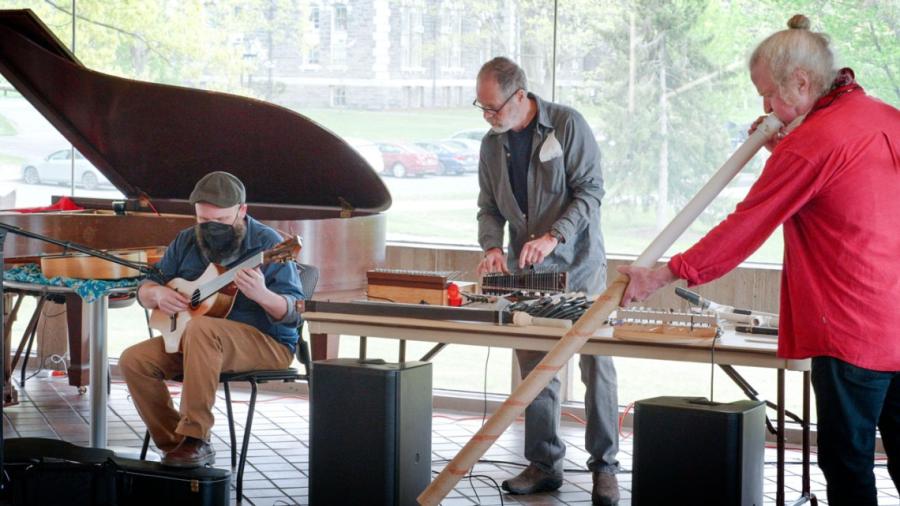The FutureSounds Festival – an instrument-builder’s extravaganza hosted by the Cornell ReSounds Project, featuring guest builders and performers as well as the newly designed instruments and compositions by Cornell students, took place May 13 at the Herbert F. Johnson Museum of Art.
“The festival’s objective was to enable attendees to encounter the unfamiliar, musically speaking, and find intelligent ways to make sense of this encounter,” said Ryan McCullough, D.M.A. ’20, visiting lecturer, who co-organized the festival with Elizabeth Ogonek, assistant professor, both in the Department of Music in the College of Arts and Sciences.
The FutureSounds course, co-taught by Ogonek and McCullough, emphasized the dialogue between past and future by considering new music written for old and newly constructed instruments. Students developed approaches to alternative tuning systems, notation, performance practice, sound color, and musical works and collaborations, extending the existing sound world. A sneak preview of the class’s projects may be viewed online.
“The fundamental premise of a class called ‘FutureSounds’ is necessarily to grapple with the question of ‘what comes next’ for music,” McCullough said. “By having our students inhabit basically every musical job – composer, instrument builder, and performer/interpreter – we were challenging them to really get under the skin of what makes music tick.”
“We actively designed the course and course projects in a way that we hoped would illuminate the interconnectedness between listener, designer, builder, composer, performer and chamber musician,” Ogonek said. “One particular win, in my mind, was watching students realize that design pitfalls could actually become compositional opportunities.”
The May 13 festival featured performances on the students’ newly created instruments, along with talks and workshops from the guest builders.
Among the featured guests were Bart Hopkin, a maker of acoustic musical instruments and author of numerous books on instruments and their construction; Jesse Jones, a composer and multi-instrumentalist with a focus on innovative instrument design and construction; and Cory Smythe, a pianist who has worked closely with pioneering artists in new, improvisatory, and classical music, as well as making many electronic modifications of the piano. The final performer, Mark Stewart, is an multi-instrumentalist as well as a singer, song leader, composer, improvise, and instrument designer. Since 1998 he has recorded, toured and served as musical director with Paul Simon.
The group improvisations were a highlight of the festival, according to the organizers.
“Our students were really listening intently to each other. I’d like to think that more than anything we were teaching a class about listening, so that felt like a real victory,” McCullough said.
In addition to student performances and demonstrations during the festival, Hopkin led a free instrument-building workshop. The festival concluded with a performance by the guest artists in the museum’s Appel Lobby. Jones, Hopkin and Stewart played an improvised set on instruments they had built, and Smythe played a solo piano set for his hallmark microtonal piano setup that “always seems to melt the sound of the instrument in the most exquisite way,” said Ogonek.
She added: “It was really inspiring to see these world-class musicians working inside these really unusual and unfamiliar sound worlds and bringing the same attention, detail, and energy as they would to standard repertoire. “
Cornell ReSounds aims to establish Cornell as a center for the design and creation of new musical instruments and a hub for Cornell’s creative artists – a conversation between the future of instrument-building and collaborative artistic creation. Looking at tradition and past inventions as a way forward, Cornell’s technologists, engineers and instrument builders are working alongside performers and composers to create a body of site-specific work for these instruments.
ReSounds is funded by a New Frontier Grant awarded by A&S, as well as by support from the Cornell Council for the Arts and by a Humanities Impact Grant funded by the Office of the Vice President for Research and Innovation.
Read the story in the Cornell Chronicle.






